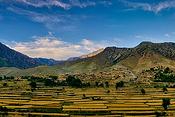Ever since the Soviet Union left Afghanistan in 1980, the country has been alone with no true government to face over 23 years of civil war. In 1994, the Taliban took control of the nation, but after supporting terrorism and Osama bin Laden's al-Qaeda network, they too were removed from power in the year 2001. Meetings were held in Bonn, Germany to decide the future of Afghanistan. International representatives created The Afghan Interim Administration (AIA) to temporarily be in control, while a Loya Jirga would be assembled to create a more permanent government over the next two years. Not only is Afghanistan starting from scratch politically, but since the overthrow of the Taliban, opium production has skyrocketed (damaging other economic projects), relations with neighbors has suffered due to the millions of Afghan refugees that have been living in Pakistan and Iran for years, and foreign security forces have been brought in as there is no national army or police force in existence.
The most dramatic change since the Taliban is the role of women in society. From 1994-2001, women were banned from walking outside their homes without being accompanied by a male relative, denied education and medical treatment, forced to give up jobs as teachers, doctors, and government workers; and forced to comply to an extremely restrictive dress code. After the Taliban, most of these rights have legally been returned to women, but they are still facing an uphill battle. With the creation of the AIA, two women have been appointed to help in rebuilding the nation (as the Minister of Women's Affairs and the Minister of Public Health). This is a step in the right direction, but these women are still overshadowed by the voice of the numerous warlords that have much more influence in politics. At this time,


